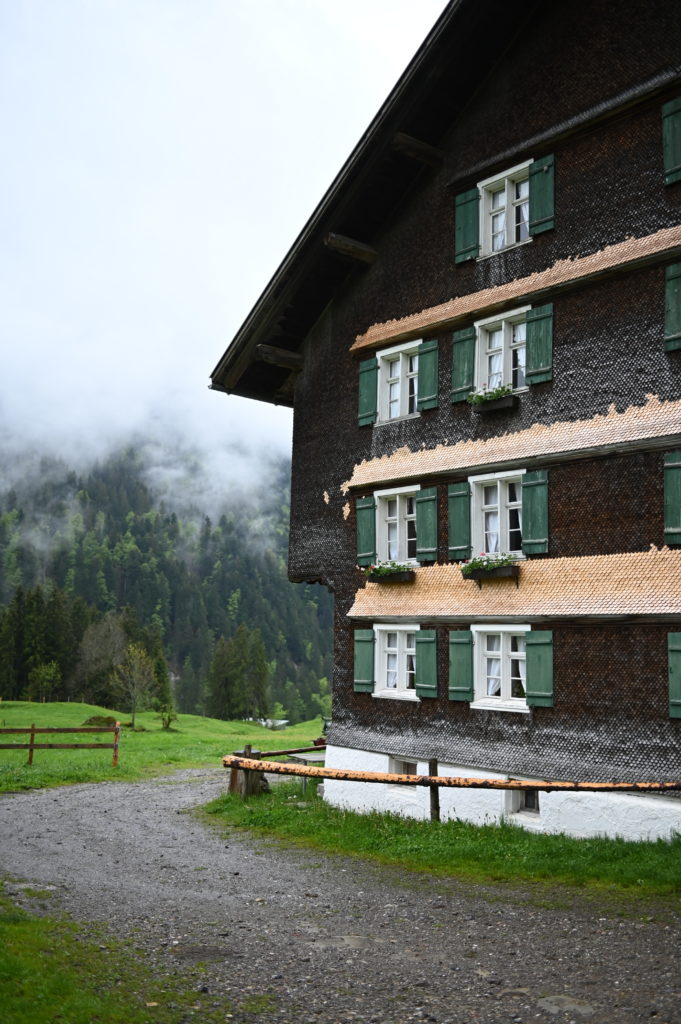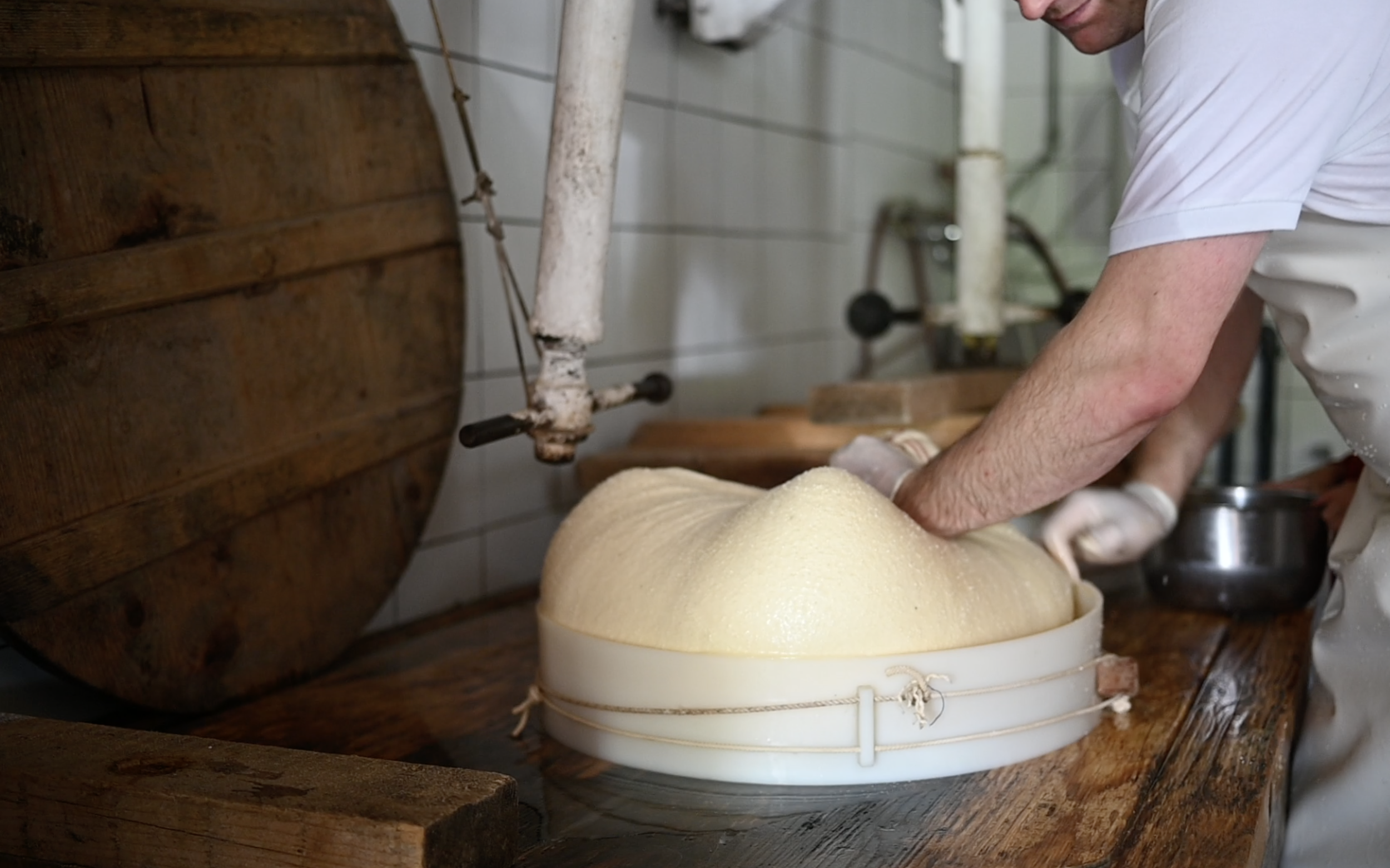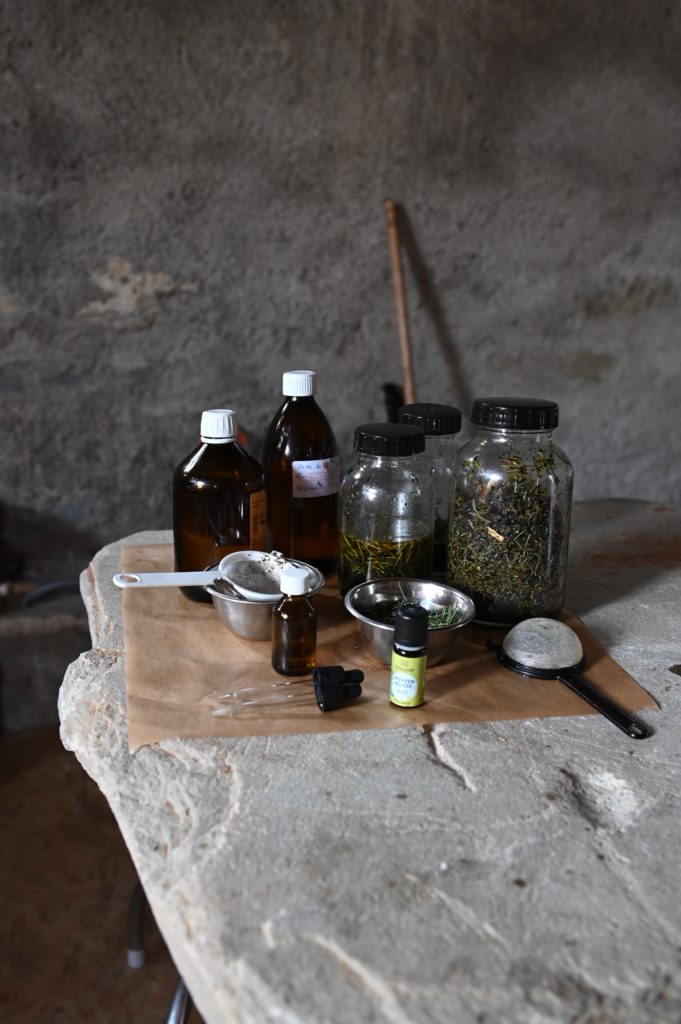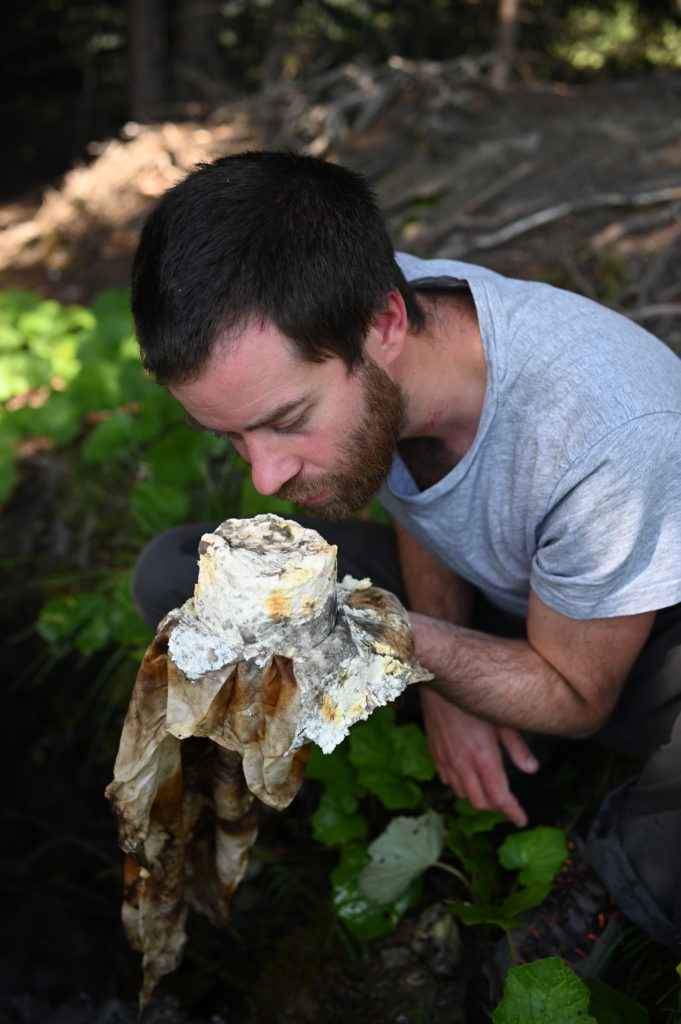Philipp Kolmann is a designer who is interested in the relationship between the human body, human culture, food and microbes. Although his focus is on certain microscopic organisms, his point of view is a macro one of an embodied symbiosis with our landscapes through food and fermentation. In his third article for The Common Table, he talks about his quest to create plant-based cheese and preserve the unique microbiomes and artisanal food culture of the Alps in the process.
I have been obsessed for some years now with artisanal cheese production, food and non-food fermentation and its global culture. I love to make cheese, but it is a very seasonally-dependent occupation and the question always remains: what to do with the rest of the year? So other projects I have been working on recently include collecting for a scent archive of alpine flora and considering the issue of how to help shape a more sustainable food system.

Current climatic and ecological threats make it evident that we need to pursue more plant-based diets. Data from the Food and Agriculture Organization of the UN shows that conventional animal products are very resource-intensive – and are responsible for 14.5 per cent of global greenhouse gas emissions. The increasing popularity of plant-based meat alternatives and diets alongside product innovations such as in-vitro proteins, vertical farms, and gene-editing to create new foodstuffs like the “Impossible Burger” is going to define the next era of food.
The market is opening up but it is not yet established enough with the right kind of products. Most current plant-based meat substitutes are geared towards creating ersatz meat and are also highly processed and therefore not understandable for the customer. Moreover, there is little emphasis on promoting new ways of eating that need to become culturally accepted. Designing with fermentation, a key process that connects all the above with our culture, is essential to generating an integrated momentum, and a human food future that can continue to coexist with other species.

One of my biggest goals is to develop educational programmes that fill the gap between sustainable food production and our sensory instincts. In parallel to my ongoing, in-depth investigation of artisanal cheese production, I have been looking into other traditional protein-based fermentation processes and cultures around the world. Searching for possible collaborations between them, in the pursuit of creating a process that includes local landscape cultivation with a product and flavour culture known to European tastes. One example could be developing plant-based cheese.
Instead of radically imagining the total loss of regional cheese production, I envision a coexistence, not just with or between multiple species but also between a possible dairy farming culture that continues to provide culturally and nutritionally relevant foods as well as giving space to a new form of food culture that welcomes plant-based proteins as something truly local – provoking new ways of land use and consumption culture.

One of the parallel fermentation processes with interconnected aspects I came across was cheese and miso. Both come from protein sources (milk and soybeans respectively) that have been made easier to digest and converted into more nutritious foods through fermentation. Both have become staples in their respective culinary cultures through the introduction of microbes. In both cultures too, the mastering of fermentation has evolved over time, utilising the power of our ancient microscopic symbionts to become fundamental to our diets.
Fermentation unlocks all the nutrient potential of otherwise rather indigestible legumes and makes them delicious at the same time.
So if we are to create a plant-based, non-dairy cheese, what kind of plants could be suitable to use? An obvious answer would be the legume family, which includes peas, beans, lentils, chickpeas and even peanuts. Legumes have been part of human diets for even longer than livestock and their products. Digging deeper into culinary legume use, it is very evident from preparation techniques used for centuries, if not millennia, all over the globe, that wild fermentation is the key to digestibility: fermentation unlocks all the nutrient potential of otherwise rather indigestible legumes and makes them delicious at the same time.

The global production volumes of key legumes such as soy and fava beans are huge and could easily cover the protein demand of our world population. But ask most soybean farmers who they are growing their proteins for, and they will tell you that 80 per cent of plant protein produced worldwide is grown to feed livestock for our meat and dairy consumption. Soybean production is also one of the biggest causes of deforestation in places like the Amazon Rain Forest. It’s absurd! We already have a plant-based protein infrastructure available right there. Would it not make sense to more fully access these resources to generate products using processes through fermentation for our own diets?
Back to cultural implementation. Despite the more sustainable environmental and food-production logic, I continue to be haunted by the question “Why would I want to eat plant-based cheese?” especially when I am so obsessed with and so love artisanal cheese. The answer lies, I believe, exactly in this love and deeply-rooted respect. The rich depth and variety of cheese culture and flavours is not an obstacle to be overcome, but a driving force to create something that is not trying to imitate, but rather support already (sustainable) existing structures. My goal of a culture of plant-based cheese varieties is inspired by thousands of years of global food cultures. It is about utilising and paying respect to knowledge about fermented foods from multiple cultures, then joining them – preparing the ground for future sustainable food systems.
My goal of a culture of plant-based cheese varieties is inspired by thousands of years of global food cultures.
Recently I was given an article about a decline in bacterial culture in alpine pastures. Propionibacterium freudenreichii, is used for the production of vitamin B12 and in the dairy industry as a starter culture. It is also the main component of the secondary flora of Emmental cheese and responsible for its characteristic aromas. The threat is not to its lab-grown siblings but within its natural habitat. This bacterium prefers to grow together with clover, a meadow plant species whose presence is being harmed by several environmental conditions, including climate change but also poor management of alpine pastures. Too many cows per square metre, results in too much manure per square metre. This over fertilisation is causing a decline in biodiversity in pasture plant life, resulting in a decline in microbiological diversity, which further results in a poor diversity in the microbiome of the animals that feed on those pastures – ultimately affecting the microbial condition of the raw milk product.

This situation has hardly any effect when milk is being homogenised, pasteurised and processed into industrial dairy foods, which are anyway infused with industrial bacteria cultures after the native ones have been eliminated in the process. Where it does have consequences is in artisanal cheese production using unpasteurised raw milk and wooden receptacles. The fundamental core material of the whole cheese-making process is affected, which threatens the loss of a truly local product with its unique, culturally relevant flavour and scent profile. Not to mention the economic damage to the farmers whose arts and craft relies on a holistic microbiome – from the soil to the belly of the animal.
Back to plant-based cheese. By now, the reader should have an idea of how developing a culture of plant-based cheese in parallel to artisanal dairy cheese could have subsequent consequences for the landscape, its grazing inhabitants – and our flavour and scent heritage that I mentioned at the beginning. When addressing biodiversity, plants, animals and the issues involved in securing heritage are anchored in flavours and scents – especially when the human element is engaging with the ecosystem and not cannibalising it the way our industrial processes and systems do – and microbes are an integral, essential part of this biodiversity.
My first experiments have been with multiplying bacteria cultures found on hay collected during the summer.
Currently, this line of thought is feeding my hunger to investigate further. To test and find possible ways of projecting flavour and scents onto new mediums, helping them to shape our future food culture while engaging biodiversity and activating peaceful coexistence with multiple species.

My first experiments have been with multiplying bacteria cultures found on hay collected during the summer. Different cuts contain different plants, and these different plants contain fundamentally different biofilms, which I then used on sterile bean and lentil juices. What was fascinating was that when those legume milks started to split (the same as in cheese making after adding rennet) it was the proof that even dried hay contains the potential to serve as a starter culture for future plant-based cheese varieties without losing the power of indigenous microbes and their consequential impact on the flavour and scent of the resulting foodstuffs.

This made me wonder if this could be a way to conserve incredible finely-tuned, locally-rooted flavours whilst also motivating local taste buds towards a more plant-based diet. Again, the aim is not to create a substitute (at least not yet, transition time is both important and necessary) but maybe there is the potential there to convey the same aspects of biodiversity and multispecies interconnectedness but in a contemporary way.
Rural communities cannot be excluded from the discussion about the transition to a more plant-based culture.
Further, perhaps it could also be the beginning of a way to create alternative land uses and the generation of new sources of income for struggling rural farming communities, without losing their connection to the land and its resources. I truly believe that if an alternative (and profitable) system of land use and food cultivation could be established, most of the young generations of farmers, squeezed between subsidies and market pressures, who are currently leaving the land in their droves would welcome the chance of being proud once again of doing what their great grandparents did: living a balanced coexistence with their sounding lands and other species. Perhaps this would also show that rural communities cannot be excluded from the discussion about the transition to a more plant-based diet.
Philipp Kolmann was born and raised in Austria and currently lives between the Netherlands and Switzerland. A graduate of the Food Non Food department of the Design Academy Eindhoven, he is currently involved in a collaboration with the cultural Initiative Somalgors74 in Lower Engadin, working on an “Archive of alpine olfactory memories”, as well as site-specific flavour and scent consulting with companies in Mexico and Austria. In 2022 he will be participating in the 27th Biennial of Design in Ljubljana as part of ‘Grains for Brains’. He is also continuing his investigation into dairy culture and exploring possible shifts to plant-based processes without sacrificing strong bonds to our landscapes and artisanal food culture. You might also be interested in his other articles for The Common Table, What Is Us? and Is it Clean or is it Hygiene?






